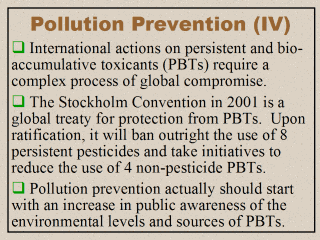 |
International
actions on persistent (P), bioaccumulative (B), and toxic (T) substances
require global consensus, which is never an easy task due to the various
complex political issues involved and to the limited resources available
across nations. Yet some such efforts have been proven successful by the
United Nations Environment Programme, when delegates from 127 countries on
23 May 2001 approved the convention on persistent organic pollutants (POPs)
held in Stockholm, Sweden. As expected, the approval underwent a great deal
of negotiations and disputes over certain economic interests and political
concerns. The Stockholm Convention is a global treaty to protect human
health and the environment from POPs, which represent a major group of PBTs
and many are considered as endocrine disruptors. The Convention has returned
to each government for ratification, which is expected to take several
years. The treaty must be ratified by 50 nations to become an international
law. In the USA, the treaty was submitted to the U.S. Senate for
ratification by President Bush in April 2002. As soon as the treaty enters
into force, it will ban outright the use of 8 pesticides (aldrin,
chlordane, dieldrin, endrin, heptachlor,
hexachlorobenzene, mirex, and toxaphene). It will also
take initiatives to reduce the use of DDT, PCBs, and the
by-products dioxins and furans. Collectively this group is
referred to as the dirty dozen.
In closing the lecture here, it should be pointed out that, at the more
micro level, pollution prevention should start with an effective increase in
public awareness of the environmental levels and the sources of PBTs.
This is essentially one of the challenges included in the Great Lakes
Binational Toxics Strategy of 1997 between Canada and the USA.
 |
Go to Comment Form |
|